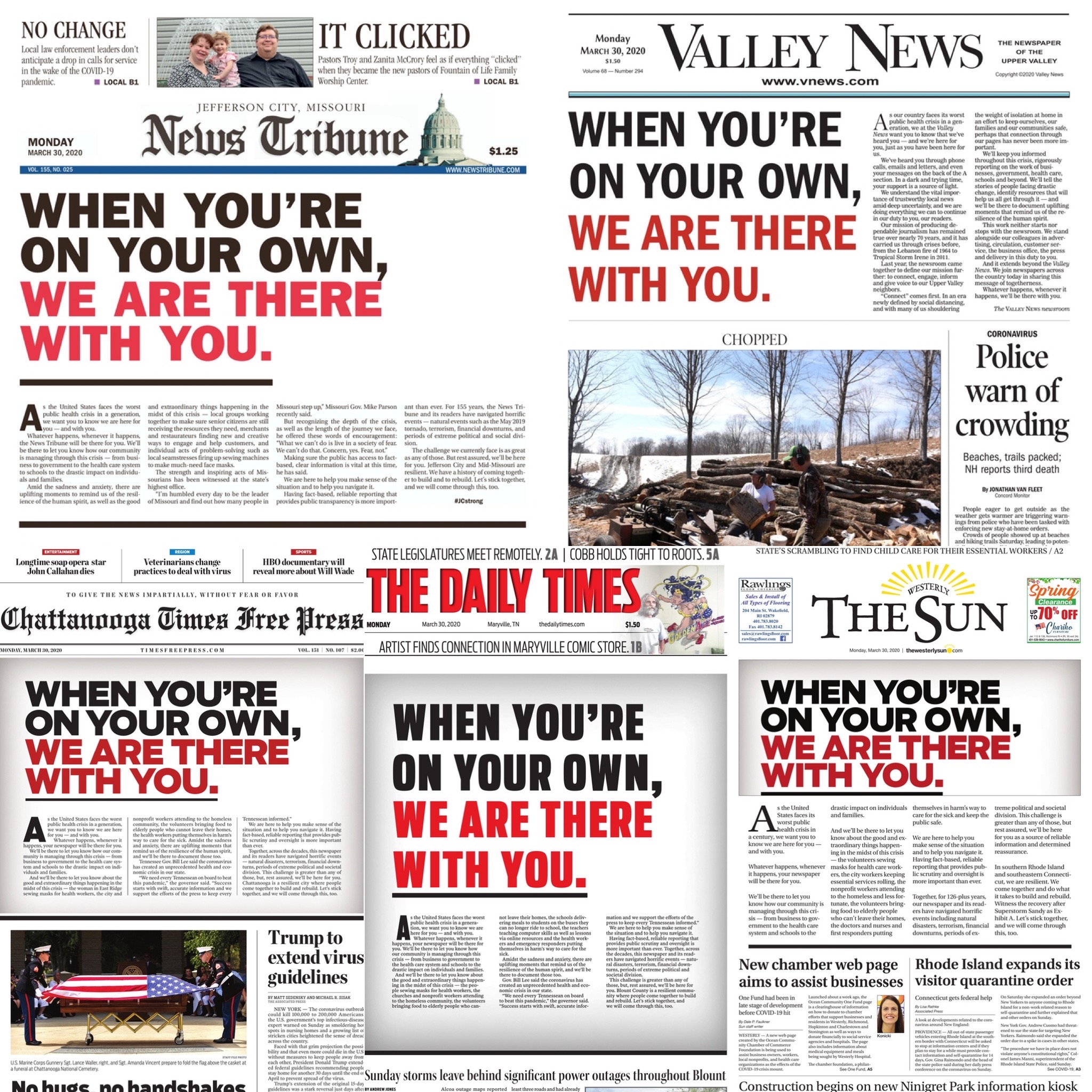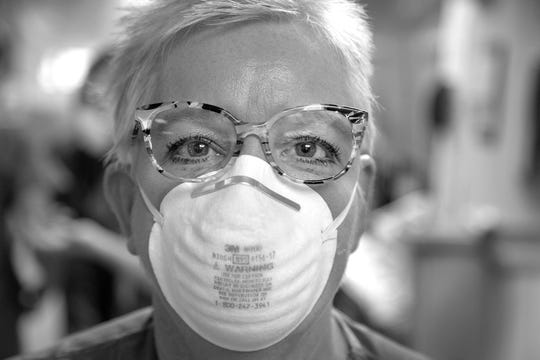“Arlene Van Dyk doesn’t know if her patients can hear her,” Lindy Washburn wrote for northjersey.com and The (Bergen, New Jersey) Record on Friday, March 27. “They are unresponsive, sedated into paralysis so that machines can do the work of their lungs. She speaks to them anyway.”
As coronavirus cases double overnight in many places, we’re just starting to learn what it’s like for the professionals caring for people inside hospitals around the country. For lots of reasons — medical privacy, ethics, public health — journalists aren’t inside many hospital rooms right now to show the world what’s happening. But Washburn does that with her reporting and writing. She writes this:
“Behind the clear plastic tarp that separates the hot zone from the clean zone at the intensive care unit, amid the low-pitched alarms of the ventilators and the high-pitched beeps of the intravenous pumps, lie 19 people. Nineteen people in a life-and-death struggle with the new coronavirus.”
And this:
“Connected to a hanging garden of intravenous drips, ventilator hoses and electronic monitors, their bodies are mounting an immune response to an unrecognized invader.”
Washburn has covered Holy Name Medical Center in Teaneck, New Jersey, for a long time, she said in an email.
“They have been hardest hit by the explosion of cases in Bergen County, New Jersey, and I’ve done several stories about their response.”
That includes watching a drill on the use of personal protective equipment, a ticktock look at how the surge hit the hospital and a story about how the hospital’s CEO was diagnosed with the virus. She writes an issue story almost every day, “but as it became clear that there would be a shortage of critical-care nurses, I decided it would be good to profile what they actually do.”
The hospital connected Washburn with Van Dyk, and Washburn told the story as best she could after a 30-minute phone interview.
“I have photos from the ICU that helped me visualize it, and I asked her to describe what she saw as she looked around the room,” Washburn said. “I texted her a couple of times to ask about the sounds. We just talked about her day and how it unfolds.”
The day before that interview, Washburn lost a friend, journalist Alan Finder, to the coronavirus.
“In talking to his wife, a former coworker, I found the most painful thing to be her inability to be with him when he struggled and died.”
When Van Dyk, the critical care nurse, talked about her own experience with that, Washburn started to cry.
“I never have done that, in all 30 years of health reporting,” she said. “I had to stop for a minute, and I explained why to her. It felt like I kind of experienced her calming manner myself.”
Washburn writes that once or twice a day, Van Dyk tries to connect her patients with their families.
“She uses an iPad wrapped in plastic. The anxious families see and speak to their loved ones, she says. The patients, inert in medically induced comas, do not reply. Her voice is calm as she describes these scenes that wrench her heart. ‘You know how when you’re a mom or dad, you don’t want to cry or lose control in front of your kids?’ she says. ‘That’s how it is.’”
After emailing on Friday, I called Washburn on Monday to see what news of furloughs across Gannett, which owns Washburn’s publication, would mean to her.
“It’s really new and each of us, I’ve been told, is going to be required to take one week per month off in April, May and June, and that just seems incredible to me,” she said.
“How can we stop reporting this? I just don’t know.”
Here are some other ways local newsrooms are covering this story. (Please share what you’re seeing. We’re always looking for more.)
- Philadelphia Inquirer reporter Ellie Silverman went to cover a coronavirus testing site, Joseph Lichterman reported last week for The Lenfest Institute, and came up with a smart way to reach people. “She walked up and down the line of cars with a hand-made poster board asking people to call her to chat. They did. And The Inquirer published a story about their experiences.”
- The Stand, an online community paper in Syracuse, New York, created this Google doc with local numbers, alerts and resources that it’s updating daily.
- And in Tampa, WTVT’s Kelly Ring is reading bedtime stories to kids. My colleague Al Tompkins wrote about this in his daily newsletter, which you should definitely subscribe to.
Newsroom watch:
What a day.
- The Tampa Bay Times, which Poynter owns, announced Monday that it’s dropping print down to two days a week and furloughing non-newsroom employees. Poynter’s Rick Edmonds spoke with the Times CEO Paul Tash about the news.
- In a memo Monday morning, Gannett told staff “that it will be instituting furloughs and other cost reductions in response to big advertising declines.”
- The 13-year-old Waterbury (Vermont) Record printed its last edition last week. “Clearly, this decision is precipitated by the coronavirus crisis, but it’s also about economics,” said publisher Greg Popa in the Record. “The Record has never been profitable, but we were in this for the long haul.”
- Ken Doctor wrote on Monday for Nieman Lab about how for the local news industry, “the advertising collapse is knee-buckling.”
Help wanted
Check out these resources and free trainings to help you and your newsroom cover the coronavirus:
- National Geographic has a COVID-19 Emergency Fund for Journalists, which will be offering between $1,000 and $8,000 for “local coverage of the preparation, response, and impact of this global pandemic as seen through evidence-based reporting”
- The Carter Center has these mental health resources for journalists.
- The National Association of Hispanic Journalists is hosting weekly webinars on mental health in both English and Spanish.
- And IRE has a free webinar at 2 p.m. Eastern time Wednesday, April 1, on fighting for open records during this crisis.
Bright spots
- In Washington, D.C., local TV newsrooms banded together to deliver a message about solidarity, “Because local news is your news, and together, we’re better,” Adam Jacobson reported for Radio and Television Business Report.
“No matter who you choose, know one thing — we are here for you.” Grateful for my incredibly dedicated and hard-working colleagues at @wusa9 — and our friends at @nbcwashington, @fox5dc & @ABC7News. pic.twitter.com/wFECwIfWw0
— Scott McCrary (@Scott_McCrary) March 27, 2020
- News Media Alliance and America’s Newspapers sent a letter to Washington about federal help for local news.
- Facebook’s Journalism Project announced Monday an additional $100 million for the news industry during the coronavirus crisis, “$25 million in emergency grant funding for local news through the Facebook Journalism Project, and $75 million in additional marketing spend to move money over to news organizations around the world.”
Today’s front:
Finally, several newspapers took part in this front-page message of solidarity on Monday. It started in the U.K. These fronts are via Newseum.

Kristen Hare covers the transformation of local news for Poynter.org. She can be reached at khare@poynter.org or on Twitter at @kristenhare







